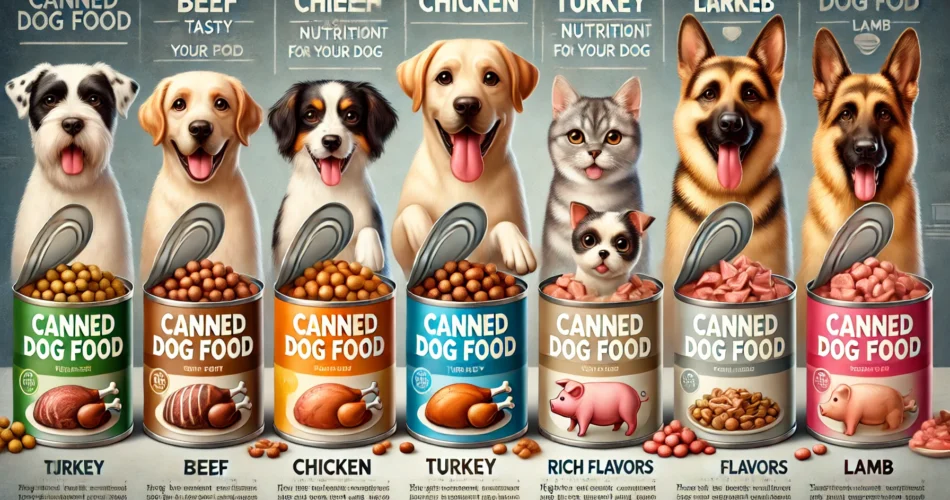Canned dog food has been a staple in the pet food market for years, offering a convenient and nutritious option for dog owners. But with so many brands and types available, it’s easy to feel overwhelmed when choosing the best one for your furry friend. Whether you’re a new pet parent or looking to switch up your dog’s diet, this guide will help you navigate the world of canned dog food, highlighting its benefits, how to select the right one, and common misconceptions. Let’s dive in!
Why Choose Canned Dog Food?
Canned dog food often gets a bad rap, but it has numerous benefits that can make it the perfect choice for many dogs. Here’s why canned dog food might be a great addition to your dog’s diet:
- High Moisture Content: Canned dog food typically contains about 70-80% moisture, which helps keep your dog hydrated, especially if they don’t drink enough water on their own.
- Rich in Flavor and Palatability: Dogs are naturally attracted to the strong aroma and taste of canned food, making it an excellent option for picky eaters.
- High-Quality Protein: Many canned dog foods offer higher protein content compared to dry kibble, supporting muscle maintenance and overall health.
- Less Preservatives: Since canned food is sealed and cooked at high temperatures, it often requires fewer preservatives than dry food.
How to Choose the Best Canned Dog Food
Selecting the right canned dog food can feel daunting, but by keeping a few key points in mind, you can make an informed decision that best suits your dog’s needs.
- Check the Ingredients List: Look for high-quality proteins like chicken, beef, or fish as the first ingredient. Avoid products with fillers like corn or soy, artificial flavors, and preservatives.
- Consider Your Dog’s Age and Health: Puppies, adults, and senior dogs have different nutritional requirements. Opt for canned food that matches your dog’s life stage and any specific health needs, like weight management or sensitive stomach.
- AAFCO Approval: Ensure the product meets the standards set by the Association of American Feed Control Officials (AAFCO) for complete and balanced nutrition.
- Grain-Free vs. Grain-Inclusive: Grain-free diets have gained popularity, but they are not necessary for all dogs. Consult your vet to determine if your dog might benefit from a grain-free formula or if traditional grain-inclusive options are better.
Common Myths About Canned Dog Food
Let’s clear up some misconceptions that often surround canned dog food:
- Myth 1: Canned Dog Food Causes Dental Issues
While it’s true that dry kibble helps with dental health by reducing plaque, canned food itself does not cause dental problems. Regular brushing and dental treats can help maintain oral hygiene regardless of the type of food. - Myth 2: Canned Food is Too Expensive
Though canned dog food can seem pricier upfront, its high nutritional value and moisture content mean you may feed less in volume, balancing the cost over time. - Myth 3: Canned Dog Food is Just a Topping
Many believe canned food is only meant to be a topper for kibble. However, many formulas are nutritionally complete and can be fed as a standalone diet.
How to Transition Your Dog to Canned Food
Switching your dog’s food can be tricky, especially if they have a sensitive stomach. Follow these simple steps to make the transition smooth:
- Start Slow: Begin by mixing a small amount of canned food with their regular diet. Gradually increase the canned portion over 7-10 days.
- Monitor for Changes: Keep an eye on your dog’s stool, appetite, and energy levels. Any drastic changes should be discussed with your vet.
- Maintain Consistency: Once your dog has fully transitioned, stick to a feeding schedule to keep their digestive system in balance.
The Environmental Impact of Canned Dog Food
Interestingly, canned dog food is often more eco-friendly than you might think. Most cans are made of recyclable materials like aluminum and steel, which can be repurposed indefinitely. Additionally, since canned food contains less filler, it can help reduce the overall carbon footprint of pet food production. When buying canned food, look for brands committed to sustainable practices to further support environmental health.
Canned dog food can be a fantastic choice for many dogs, providing a nutritious, palatable, and convenient feeding option. By carefully selecting high-quality canned foods that meet your pet’s needs, you can ensure they receive the best possible diet. Always remember to consult your veterinarian when making any changes to your dog’s diet to ensure it aligns with their specific health requirements.




